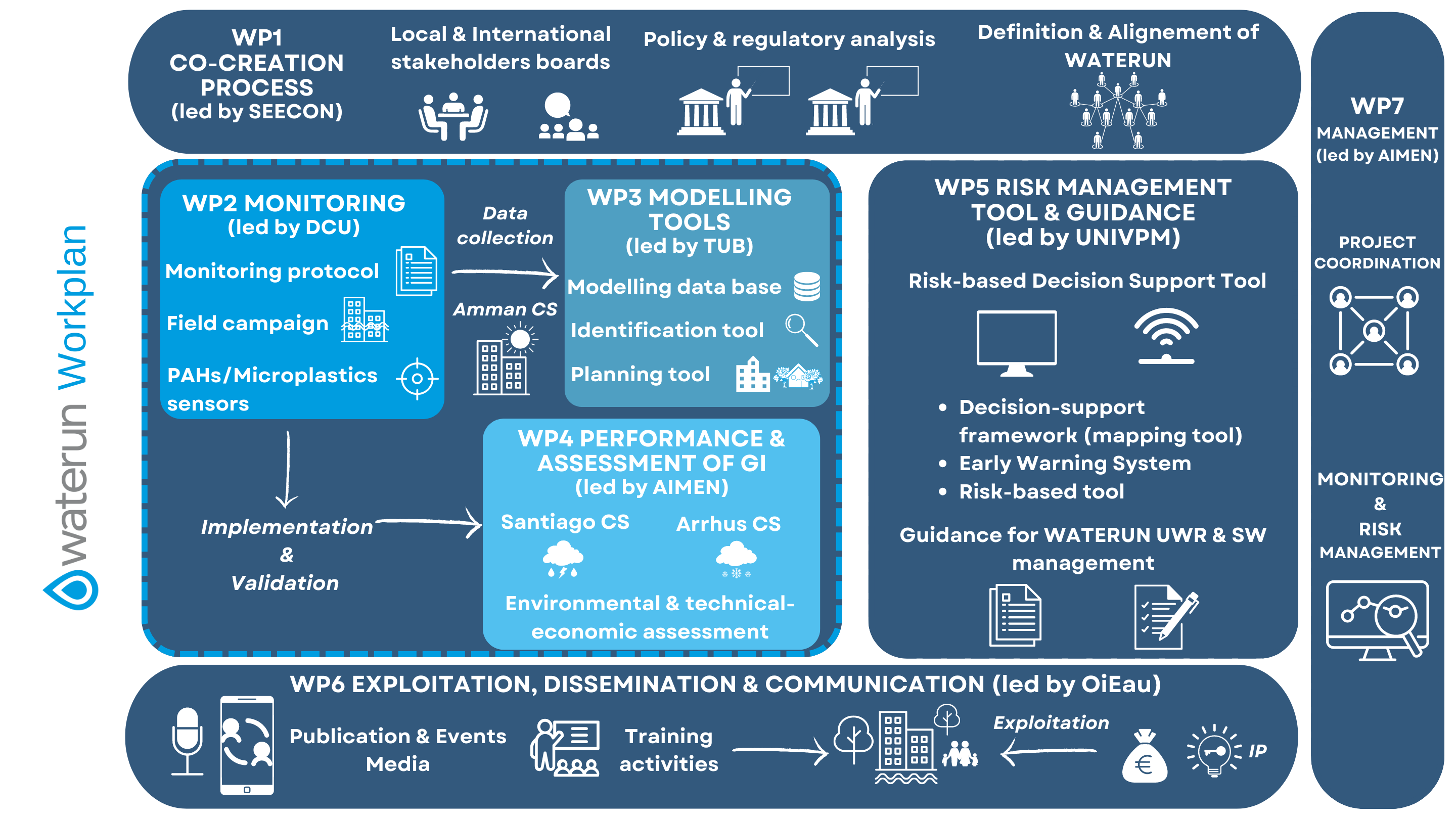Workplan
Body
The work plan is designed to accomplish the project objectives, within a total budget of 4.35 million€ and a total timespan of 48 months. Tasks have been organised under 7 distinct work packages, led by AIMEN responsible of organising the work, delivering results, and ensuring the exchange of required information among the WP.

WP1, led by SEECON, aims to design and implement a co-creation process for an efficient and multidisciplinary participation in the decision-making process and to establish a methodology. It include 2 tasks:
- Task 1.1 - WATERUN Co-creation process: The co-creation process will be initiated by conducting a stakeholder mapping along the UWR management cycle. Once this information is gathered, a stakeholder participation strategy will be prepared.
- Task 1.2 - Requirements, specifications and architecture of WATERUN: This task carried out by AIMEN defines the working framework to assure the proper information flow among all the working teams.
WP2 is focused on advanced monitoring strategies for diffuse pollution control. This work package, led by DCU, includes 3 tasks
- Task 2.1 - Definition of a monitoring protocol for UWR control, counting on the development of advanced sensors for on-site detection of PAH and microplastics.
- Task 2.2 - Field campaigns on the 3 CS.
- Task 2.3 - Portable and low-cost sensors for on-site measurement of PAH and microplastics will be developed
WP3 objective is to develop and implement modelling tools for UWR management. This Work Package led by TUB, is divided in 4 tasks:
- Task 3.1 - Development of modelling databases for the case studies, which will constitute the common data infrastructure for the modelling tools
- Task 3.2 - Development of diffuse pollution identification tool : an open source application will be developed, tested and applied by TUB in collaboration with the other partners
- Task 3.3 Multi-scale modelling approach to rank severity of critical source areas through the adaptation of the Storm Water Management Model as an urban drainage model to be integrated into the identification tool of Task 3.2.
- Task 3.4 Development of the planning tool which will use the MUST-B approach with hydraulic models to estimate the maximum capacity of GI for reducing UWR
WP4, also called “Performance and assessment of GI”, is led by AIMEN. It aims to design, implement and validate Green Infrastructures (GI) in Santiago and to optimise Aarhus case study’s GI. It includes 4 tasks
- Task 4.1 - GI design and construction at Santiago CS : 3 GI will be carried out at Santiago based on the knowledge from WP1-WP3
- Task 4.2 - Operation and validation of Santiago CS GI with the monitoring protocol from T2.1
- Task 4.3 - Operation, performance analysis and upgrade of Aarhus CS GI, in order to enhance the understanding and performance on the use of GI to manage urban diffuse pollution through the existing GI in Aarhus city
- Task 4.4 - Environmental and technical-economic assessment of the GI using Life Cycle Assessment methodology
WP5, led by UNIVPM, consists in develop a risk management tool and a guidance for decision making. To develop theses 2 tools, 4 tasks are needed:
- Task 5.1 Decision-support framework (risk-based DSS), based on environmental and health risk assessment in the form of a mapping tool (GIS-based)
- Task 5.2 - “Early Warning System” for a safe UWR reuse and management. EWS will produce “warning”, which can be displayed in the (GIS-based) decision-making platform develop during T5.1.
- Task5.3 – Development of a risk-based tool for Water Sensitive Urban Design, which will allow to evaluate the reduction of the health-risk after the implementation of different GI and will be integrated in the risk-based DSS (T5.1)
- Task 5.4 - Guidance for the methodological implementation of WATERUN UWR management = a ready-made output for decision-making and governance in urban areas facilitating the elaboration of UWR management plans of cities
WP6, includes exploitation, dissemination and communication of WATERUN results. This Work Package is led by OiEau and includes 3 tasks:
- Task 6.1 – Management and exploitation of the Intellectual Property of the knowledge and innovation developed in the project
- Task 6.2 - Dissemination and Communication aims to facilitate exchanges between WATERUN partners and to maximise the dissemination of project results
- Task 6.3 - Technology Transfer and training activities to assure the knowledge transfer from Research and Technology Organisation to companies involved in WATERUN project
WP7, concern management & coordination and is led by AIMEN. It includes 3 tasks:
- Task 7.1 – Project Coordination, i.e. centralisation of the single contact point with the European Commission Agency
- Task 7.2 - Monitoring and risk management of the project with deliverables and milestones
- Task 7.3 - Strategic management of the project, which included consortium orientations, adjustments of the development trajectory and decisions in relation to consortium management